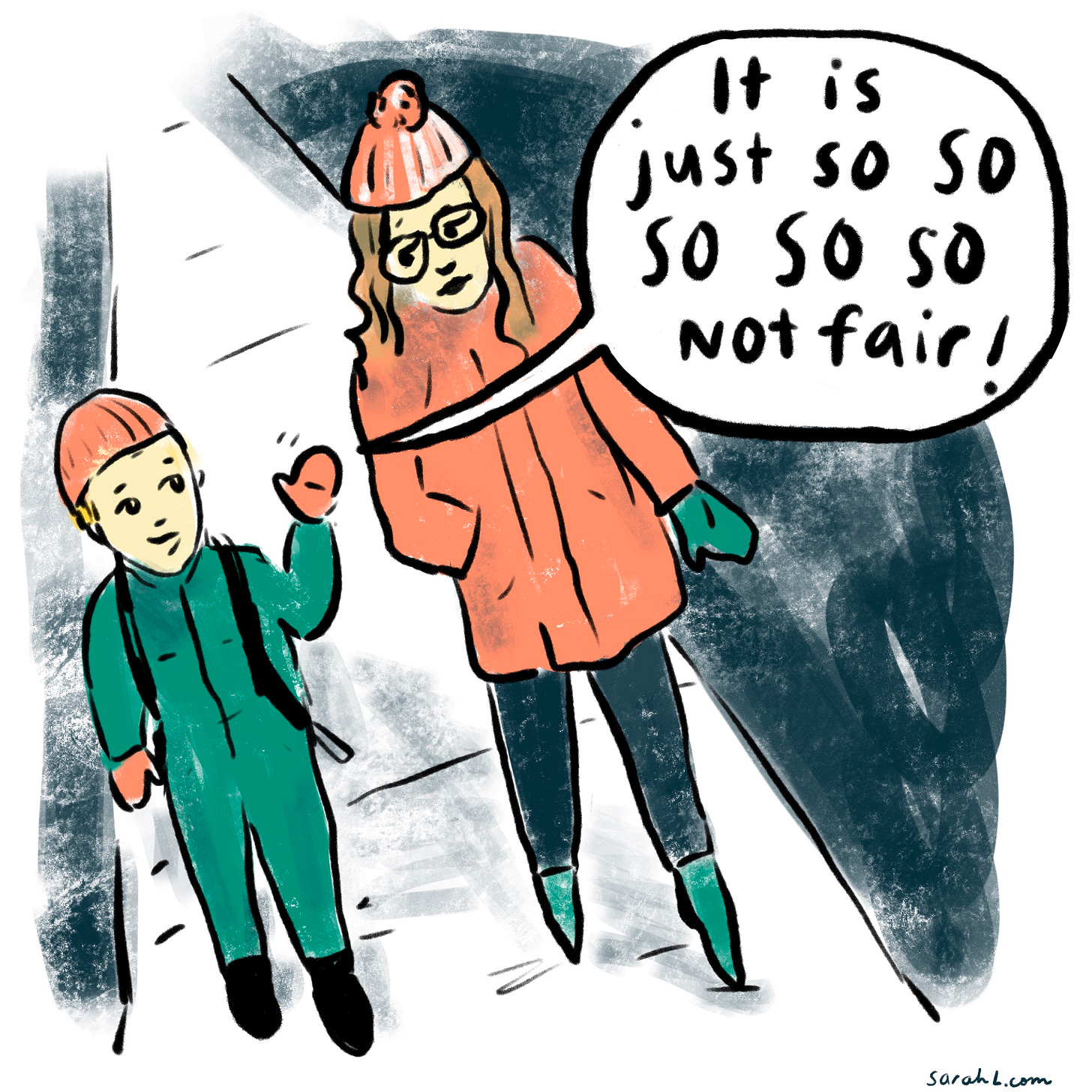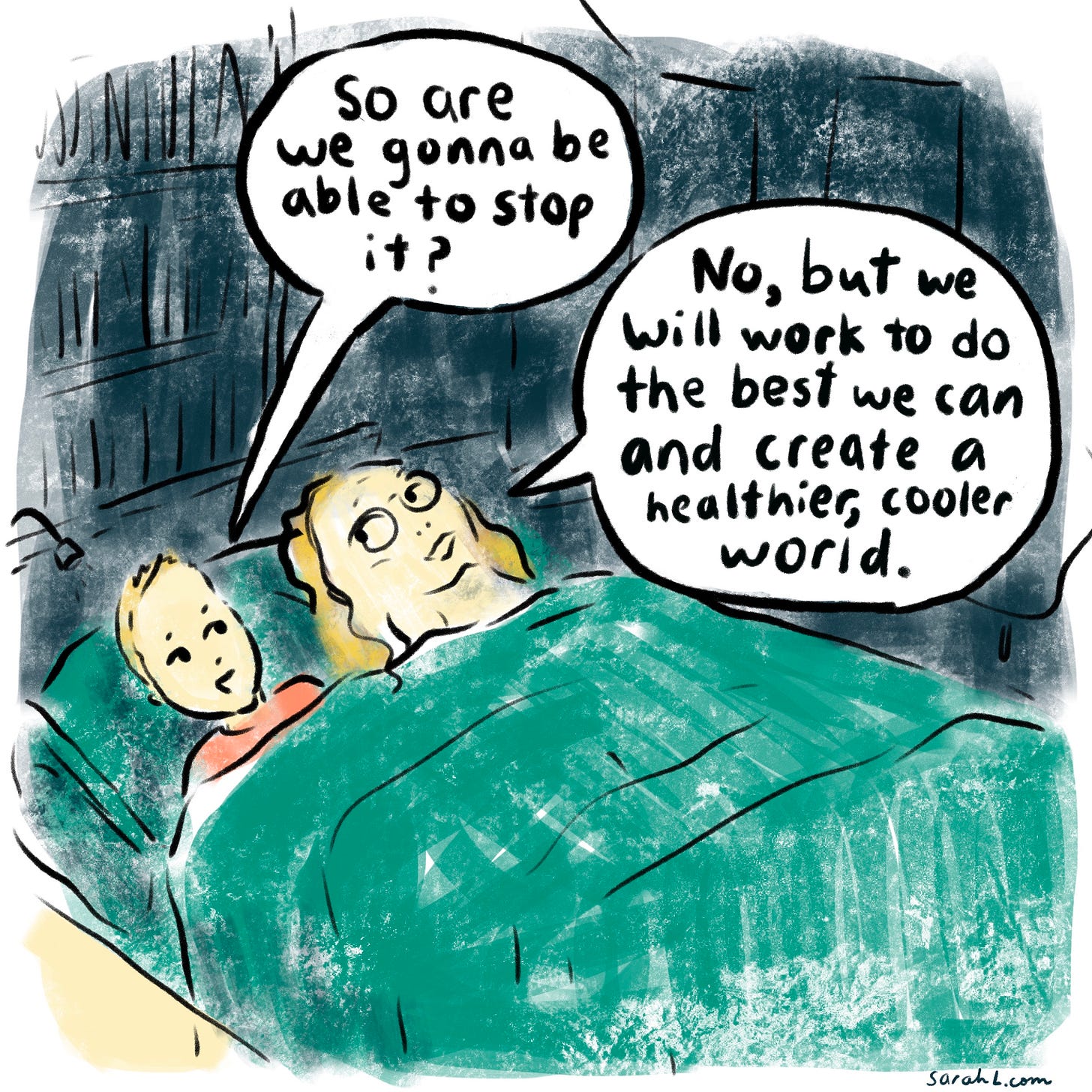Opinion Advocates for ideas and draws conclusions based on the author/producer’s interpretation of facts and data.
Talking (and Not Talking) About the Climate Emergency With My Kids
My kids know my day job is in climate. I mean, I wear a giant button that says “Talk Climate to Me,” and I mutter about wetlands under my breath while buttering their toast.
At the same time, I try not to talk about the climate crisis too much. I don’t want it to pervade their every moment, their already restricted childhoods.
But I know they’re smart enough to figure things out.

And their emotional intelligence is so keen.
Which is why I try to talk less about my emotions and more about what we’re doing.
I try to explain what’s happening in easy-to-understand language and contextualize how the world needs to change.
I answer straightforwardly when they ask me the tough questions, but I try to highlight the pathways to a positive outcome, which are real.
I want them to be able to fight the doomer nihilism that they’ll soon encounter. This crisis is both unfathomably challenging and eminently mitigable.

I learn a ton from them, too. I’m constantly surprised by their clarity when it comes to injustice. We’ve learned about corporate union busting and the overreach and barbarity of U.S. Immigration and Customs Enforcement from watching Superstore. I’m so jaded it didn’t shock me. But my kids brought their fresh-eye game.

I want them to have enough understanding to feel strong and take action where they can, but I don’t want to be a climate stage mom, overwhelming them with my own goals and actions. I want them to be kids, unencumbered by weight that should not be theirs to shoulder.

And I want them to love this one precious Earth, to have compassion and empathy for those suffering all over the world, so they’re motivated to protect every bit of it that they can.

It’s tough, there’s hope, let’s do this.
Your kids probably already know more than you think. It’s important to find out where they’re at and educate accordingly. Make sure to gauge for overwhelm. Writes Emma Pattee in Wired:
“Starting around 8 is when the larger perspective of climate change and its implications are beginning to be understood, and the feelings begin to arise,” [therapist Leslie Davenport] says. So before you start talking, ask what your kids already know. This is also a time to start naming feelings and practicing emotional resilience. Davenport points out that while it’s normal to feel big emotions when you learn about the world being in crisis, kids are not equipped to process those feelings. “They are left in a sense of overwhelm, which can upend just about every aspect of life,” she explains. Davenport’s book suggests “toggling,” or learning to go back and forth between distressing climate news and tools for self-regulating emotional reactions. “These are essential life skills required to successfully navigate a world with clear-minded and empathic action, especially as challenges escalate due to climate change.” This is also an age group where kids get really interested in making a difference and taking action, so finding ways to work with your child on climate action can be empowering and connecting for both of you. [Author Mary DeMocker] points out that there is a big range of ways kids can make a difference. The more introverted ones, for example, may not be as comfortable in a political arena but might want to contribute their gifts in another way, through art, writing, or being part of a kid-led effort like the 1 trillion trees campaign.
How to talk with kids about climate change (Yale Climate Connections)
How to talk honestly to kids about climate change — and still give them hope (TED, by the wonderful Katharine Hayhoe)
How to talk to kids about climate change (NPR)
Here’s how to talk with your kids about climate anxiety (Grist)
This Week
Do you talk about climate with your kids or your friends’ kids? What do you say? Let me know!
Last Week
Angry words. Lovely Nancy sent me these little nuggets of brilliance.
Two things.
One is the old bumper sticker: if you aren’t angry, then you aren’t paying attention. It doesn’t mean you should be angry all the time but people who aren’t angry? Well, you have to wonder.
This painting is called: “Courage, Anxiety and Despair: Watching the Battle” by James Sant (1820-1916).
People Dancing
Thanks so much for reading. Hope you are cozy, happy, healthy, and able to find the time to move your body. As always, let me know how to make MVP better.
Have a lovely weekend,
Sarah
P.S. This is my newsletter for the week of Dec. 8, 2021, published in partnership with YES! Media. You can sign up to get Minimum Viable Planet newsletter emailed directly to you at https://mvp.substack.com.

|
Sarah Lazarovic
is an award-winning artist, creative director, freelance animator and filmmaker, and journalist, covering news and cultural events in comic form. She is the author of A Bunch of Pretty Things I Did Not Buy.
|














